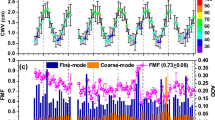Abstract
Aerosol radiative effects over two environmentally distinct locations, Kanpur (urban site) and Gandhi College (rural location) in the Indo-Gangetic plain (IGP), a regional aerosol hot spot, utilizing the measured optical and physical characteristics of aerosols, an aerosol optical properties model and a radiative transfer model, are examined. Shortwave aerosol radiative forcing (ARF) at the top of the atmosphere (TOA) is < −12 W m − 2 over Kanpur and Gandhi College. ARF at the surface is ≥ −30 W m − 2. Atmospheric warming is maximum during premonsoon (>30 W m − 2). Shortwave atmospheric heating due to aerosols is >0.4 K/day over IGP and peaks during premonsoon at >0.6 K/day due to lower single scattering albedo (SSA) and higher surface albedo. TOA forcing is always less negative over Kanpur when compared to Gandhi College due to lower surface albedo except in postmonsoon owing to higher SSA. This happens as TOA forcing depends on SSA and surface albedo in addition to aerosol optical depth. The magnitude of longwave forcing and atmospheric cooling in an absolute sense is significantly small and contributes only about 20% or less to the net (shortwave + longwave) forcing. Aerosol radiative effects over these two locations, despite differences in aerosol characteristics, are similar, thus confirming that aerosols and their radiative influence get transported due to circulation. ARF over Kanpur and Gandhi College is an order of magnitude higher when compared to greenhouse gas forcing. A large reduction in surface reaching solar irradiance accompanied by large atmospheric warming can have implications on precipitation and hydrological cycle, and these aerosol radiative effects should be included while performing regional-scale aerosol climate assessments.





Similar content being viewed by others
References
Andrews E, Sheridan PJ, Fiebig M, McComiskey A (2006) Ogren JA, Arnott P, Covert D, Elleman R, Gasparini R, Collins D, Jonsson H, Schmid B, Wang J (2006) Comparison of methods for deriving aerosol asymmetry parameter. J Geophys Res 111:D05S04. doi:10.1029/2004JD005734
Auffhammer M, Ramanathan V, Vincent JR (2006) Integrated model shows that atmospheric brown clouds and greenhouse gases have reduced rice harvests in India. Proc Natl Acad Sci 103:19668–19672
Dey S, Tripathi SN (2008) Aerosol direct radiative effects over Kanpur in the Indo-Gangetic basin, northern India: long-term (2001–2005) observations and implications to regional climate. J Geophys Res 113:D04212. doi:10.1029/2007JD009029
Dubovik O, King MD (2000) A flexible inversion algorithm for retrieval of aerosol optical properties from Sun and sky radiance measurements. J Geophys Res 105:20673–20696
Dubuisson P, Buriez JC, Fouquart Y (1996) High spectral resolution solar radiative transfer in absorbing and scattering media: application to the satellite simulation. J Quant Spectrosc Radiat Transfer 55:103–126
Eck TF, Holben BN, Dubovik O, Smirnov A, Slutsker I, Lobert JM, Ramanathan V (2001) Column-integrated aerosol optical properties over the Maldives during the northeast monsoon for 1998–2000. J Geophys Res 106:28555-28566
Gautam R, Hsu NC, Lau, K-M, Katafos M (2009) Aerosol and rainfall variability over the Indian monsoon region: distributions, trends and coupling. Ann Geophys 27:3691–3703
Hess M, Koepke P, Schult I (1998) Optical properties of aerosols and clouds: the software package OPAC. Bull Am Meteorol Soc 79:931–844
Lau K-M, Kim K-M (2006) Observational relationships between aerosol and Asian monsoon rainfall, and circulation. Geophys Res Lett 33:L21810. doi:10.1029/2006GL027546
Liou KN (1980) An introduction to atmospheric radiation, 392 pp. Academic, San Diego
Menon S, Hansen J, Nazarenko L, Luo Y (2002) Climate effects of black carbon aerosols in China and India. Science 297:2250–2253
Michalsky JJ, Anderson GP, Barnard J, Delamere J, Gueymard C, Kato S, Kiedron P, McComiskey A, Ricchiazzi P (2006) Shortwave radiation closure studies for clear skies during the atmospheric radiation measurement 2003 aerosol intensive observation period. J Geophys Res 111:D14S90. doi:10.1029/2005JD006341
Mishchenko MI, Travis LD, Kahn RA, West RA (1997) Modeling phase functions for dustlike tropospheric aerosols using a shape mixture of randomly oriented polydisperse spheroids. J Geophys Res 102:16831–16847
Ramachandran S, Rengarajan R, Jayaraman A, Sarin MM, Das SK (2006) Aerosol radiative forcing during clear, hazy, and foggy conditions over a continental polluted location in north India. J Geophys Res 111:D20214. doi:10.1029/2006JD007142
Ramachandran S, Cherian R (2008) Regional and seasonal variations in aerosol optical characteristics and their frequency distributions over India during 2001–2005. J Geophys Res 113:D08207. doi:10.1029/2007JD008560
Ramachandran S, Kedia S (2010) Black carbon aerosols over an urban region: radiative forcing and climate impact. J Geophys Res 115:D10202. doi:10.1029/2009JD013560
Ramanathan V, Crutzen P, Kiehl JT, Rosenfeld D (2001) Aerosols, climate and the hydrological cycle. Science 294:2219–2224
Ramaswamy V (2002) Infrared radiation in encyclopedia of global environmental change, vol I, pp 470–475. Wiley, Hoboken
Ricchiazzi P, Yang S, Gautier C, Sowle D (1998) SBDART, a research and teaching tool for plane-parallel radiative transfer in the Earth’s atmosphere. Bull Am Meteorol Soc 79:2101–2114
Singh RP, Dey S, Tripathi SN, Tare V, Holben B (2004) Variability of aerosol parameters over Kanpur, northern India. J Geophys Res 109:D23206. doi:10.1029/2004JD004966
Solomon S, Qin D, Manning M, Chen Z, Marquis M, Averyt KB, Tignor M, Miller HL (eds) (2007) Summary for policymakers, intergovernmental panel on climate change, 142 pp. Cambridge University Press, Cambridge
Srivastava AK, Tiwari S, Devara PCS, Bisht DS, Srivastava MK, Tripathi SN, Goloub P, Holben BN (2011) Pre-monsoon aerosol characteristics over the Indo-Gangetic basin: implications to climatic impact. Ann Geophys 29:789–804
Stull RB (1988) An introduction to boundary layer meteorology, 666 pp. Kluwer Academic, Dordrecht
Acknowledgements
We thank B. N. Holben, R. P. Singh and S.N. Tripathi for their efforts in establishing and maintaining the AERONET sun/sky radiometers at Kanpur and Gandhi College, the data of which are used to estimate aerosol radiative forcing reported in the study. Temperature, pressure and relative humidity are obtained from NCEP Reanalysis. Columnar ozone and water vapor are downloaded from GES-DISC, NASA.
Author information
Authors and Affiliations
Corresponding author
Additional information
Responsible editor: Euripides Stephanou
Rights and permissions
About this article
Cite this article
Ramachandran, S., Kedia, S. Radiative effects of aerosols over Indo-Gangetic plain: environmental (urban vs. rural) and seasonal variations. Environ Sci Pollut Res 19, 2159–2171 (2012). https://doi.org/10.1007/s11356-011-0715-x
Received:
Accepted:
Published:
Issue Date:
DOI: https://doi.org/10.1007/s11356-011-0715-x




